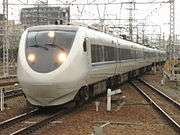415 series
| 401/403/415/421/423 series | |
|---|---|
|
A 415 series train on the Jōban Line approaching Abiko Station, July 2006 | |
| In service | 1971–present |
| Manufacturer | Hitachi, Kawasaki Heavy Industries, Kinki Sharyo, Nippon Sharyo, Tokyu Car Corporation, JR-West |
| Constructed | 1971–1991 |
| Formation | 3/4/7 cars per trainset |
| Operator(s) |
JNR (1971–1987) JR East, JR Kyushu (1987–present) JR-West (1991-present) |
| Line(s) served | Various |
| Specifications | |
| Car body construction | Steel/stainless steel |
| Car length | 19,500-20,000 mm |
| Width | 2,900-2,950 mm |
| Height | 3,654-3,670 mm |
| Maximum speed | 100 km/h (60 mph) |
| Traction system | Resistor control |
| Power supply | 120 kW |
| Electric system(s) | 1,500 V DC / 20 kV AC 50 Hz/60 Hz |
| Current collection method | overhead catenary |
| Track gauge | 1,067 mm (3 ft 6 in) |
The 415 series (415系 Yonhyaku-jūgo-kei) is a dual-voltage AC/DC outer-suburban electric multiple unit (EMU) train type introduced in 1971 by Japanese National Railways (JNR), and currently operated in Japan by East Japan Railway Company (JR East), Kyushu Railway Company (JR Kyushu), and West Japan Railway Company (JR-West).
The 415 series is descended from the 401, 403, 421 and 423 series.
Variants
The 415 series was introduced in 1971, and has since spawned six variants, as listed below.
- 415-0 series
- 415-100 series
- 415-500 series
- 415-700 series
- 415-800 series
- 415-1500 series
415-0 series
This was the original version of the 415 series train, and was manufactured from 1971 to 1974, and had air-conditioners installed in 1977. The Jōban Line and Mito Line trains were withdrawn in March 2007 in favour of the new E531 series trains, but 415-0 series were still in operation with JR Kyushu as of January 2013.[1]
Kyushu
The first 415-0 series sets allocated to Kyushu were 4-car units delivered in December 1974. These were formed KuHa 411-300 + MoHa 415 + MoHa 414 + KuHa 411-300.[1] Originally delivered in the JNR livery of brick red ("Red No. 13") with cream ("Cream No. 4") warning panels on the cab ends, these sets were repainted between 1986 and 1987 into a new livery of white with blue bodyside stripe, carried up until the present day.[1] Some sets later received life-extension refurbishment with transverse seating replaced by longitudinal seating.[1]
Livery variations
JR Kyushu set FM5 was re-painted in the old JNR livery in 2000 to commemorate the millennium celebrations in Japan. It operated in this livery until it was withdrawn in 2012.[1]
-

JR Kyushu 415-0 series set FM5 in JNR-era livery, June 2006
-
Interior of a 415-0 series trainset
415-100 series
This subseries was introduced in 1978, and most of the trains are operated by JR Kyushu, although a few trainsets were operated by JR East on the Jōban Line (the latter were withdrawn in March 2007, again in favour of the E531 series trains). The 415-100 series trainsets were built in the same exterior style as the 113-2000 series trains, but the seat pitch for transverse seating was increased from 1,420 mm to 1,490 mm, and toilets were fitted only in the KuHa 411-200 cars.[1]
Kyushu
The first 415-100 series sets allocated to Kyushu were 4-car units delivered from September 1978. These were formed KuHa 411-100 + MoHa 415-100 + MoHa 414-100 + KuHa 411-200.[1] Some sets later received life-extension refurbishment with transverse seating replaced by longitudinal seating.[1]
415-500 series
The 415-500 sub-series was introduced from January 1982 on the Jōban Line, based at Katsuta Depot. These units had all longitudinal seating.[1] Five 4-car sets were transferred to Minami-Fukuoka Depot in 1987 for use on Kagoshima Main Line duties, but these were all transferred to Kagoshima Depot by March 2007.[1] A further two 4-car sets were transferred from JR East to JR Kyushu, entering service in March 2009.[1]
-

JR Kyushu 415-500 series at Kagoshima Depot, June 2009
415-700 series
Only seven cars were manufactured, and from 1985 to 2007 was operated as part of the 7+4+4-car formations on the Jōban Line. It was withdrawn in March 2007 and scrapped in July 2008.
415-800 series
Introduced by JR-West in 1991 for service on the Nanao Line and the IR Ishikawa Railway Line. The 415-800 series trainsets are based on the 113-800 series trains.
-
JR-West 415-800 series, July 2004
-
Interior of a 415-800 series trainset
-

Fukuchiyama Line livery, Used on the Fukuchiyama Line from 1991
415-1500 series
Introduced in February 1986, the stainless steel bodies 415-1500 series trainsets look externally similar to the 211 and 213 series trains, and can be operated in 4- or 7+4+4-car formations (Jōban Line only). These trains can be coupled with the 415-500 and 415-700 series trains, and are lighter than previous variants.
-

Experimental double-deck car KuHa 415-1901, August 2002
Kyushu
12 4-car 415-1500 series sets (F1510 - F1521) were delivered to Kyushu between September 1986 and February 1987.[1] Set F1501 was also later transferred from JR East to JR Kyushu in 2009, allocated first to Minami-Fukuoka Depot, and later to Mojiko Depot (from March 2012).[1]
-
A JR East 415-1500 series on the Mito Line in September 2007
-

A JR Kyushu 415-1500 series in March 2009
References
- JR全車輌ハンドブック2009 [JR Rolling Stock Handbook 2009]. Japan: Neko Publishing. 2009. ISBN 978-4-7770-0836-0.
- JR電車編成表 2009夏 [JR EMU Formations - Summer 2009]. Japan: JRR. June 2009. ISBN 978-4-330-06909-8.
- Fukuhara (August 2010). "415系近郊形電車のあゆみ その1" [History of the 415 series suburban EMUs - Part 1]. Japan Railfan Magazine. Japan: Koyusha Co., Ltd. 50 (592): 94–99.
Further reading
- Fukuhara, Shunichi (August 2015). 415系物語 [The 415 series story] (in Japanese). Japan: JTB Publishing. ISBN 9784533105920.
External links
| Wikimedia Commons has media related to JNR 415. |
- JR East 415 series information (Japanese)


